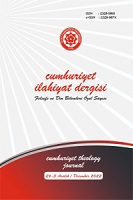Turkey and Islam Drawings by Second-Generation Turkish Children in Nottingham
Turkey and Islam Drawings by Second-Generation Turkish Children in Nottingham
Author(s): Fatma KurttekinSubject(s): Islam studies, State/Government and Education, Sociology of Culture, Migration Studies, Sociology of Education, Sociology of Religion
Published by: Cumhuriyet Üniversitesi İlahyat Fakültesi
Keywords: Religious Education; Children’s Drawings; Turkey; Islam; Turkish Weekend School;
Summary/Abstract: This study examines how children between the ages of 6 and 11, living in Nottingham, UK, understand the facts of religion and homeland through Turkey and Islam in their drawings. Art-based research method was used in the research. The obtained data was examined using semiotic method. In drawings, the values, symbols, and concepts children link with Turkey and Islam and the effect of the Turkish Language and Turkish Culture (TLTC) textbooks presented in the Turkish weekend school on this link were analyzed. 14 girl and 16 boy students participated in the study. The first collection of the drawings was made in 2017 within the scope of the researcher's doctoral study, and the second one was obtained in 2021. Since not all of them had the same material, the colors in the drawings were excluded from the evaluation scope. The drawings which were not clear enough to understand and not related to the theme of the research were also excluded. Therefore, the drawings of eight children in 2017 and 18 children in 2021 were evaluated. The drawings about Turkey and Islam were sorted by year, gender, and age variables. After that, the objects and scenes associated with the subject were encoded in the drawings. Gender and age as the sub-themes were constructed under the year as the main theme. In the end of the research, it was observed that by the age the number of the signs and symbols and clarity of the drawings increased. However, there was a differentiation in the signs, symbols, and intensities reflected in the drawings based on year, gender, and age. Yet, it was pointed out that Turkey was mostly associated with the flag and Islam with a mosque. In addition, it was determined that the themes reflected in the drawings show parallelism with the subjects in the TLTC programs and textbooks. In this regard, it is important to briefly mention subjects covering Islam and Turkey in the curriculums and the books used in 2017 and 2021. In 2017, the textbooks (Turkish Language and Turkish Culture Course for Turkish Children Abroad (1st -10th Classes/ TLTCCTCA) used in the Turkish weekend school were discontinued after the coup attempt in 2016. However, the TLTCCTCA curriculum continued to be used until 2018. When we look at the unit titles in the curriculum, 1st-3rd. Classes “Faith in Allah”, 4th5th. Classes “Faith-Islam-Morality”, 6th-7th. Classes “Islamic beliefs and values”, 8th-10th. Classes “Religion, culture and civilization” units contain topics and learning outcomes that are directly related to religion. It is also found topics and learning outcomes on the country’s history offering knowledge about war, victories, bereavements, and Atatürk’s role of foundation of Turkish Republic. By 2018, a new curriculum and textbooks consisting of 8 levels were published. One of the issues that attracts attention with the changing programs is the development of religious and national consciousness, which tries to be realized through values education by preventing ideological conflicts. In particular, the contents on the themes of “Gateway to the past, Let's go see it, Holidays and Celebrations” aim to strengthen the connection with the elements of cultural and religious identity, which are also seen in the drawings of the children. Considering the children’s drawings, it is understood that in addition to their experiences, social institutions and the concept of Turkey and Islamic facts in the society in which they live, can feed positive or negative emotions and associations. As the age and level of knowledge increased, there was a noticeable increase in the logical flow and elements for concepts related to the subject. The drawings of the girls in 2017 and 2021 were about positive emotions and values related to Turkey without differentiation, while the drawings of the boys in 2017 clearly showed the impact of the events of that date. It can be said that the fear/anxiety and life difficulties that can be seen in the drawings of boys in 2017 have decreased by 2021, and the visibility of positive warm feelings, which include love, longing, pride, and excitement, has increased. Although more detailed elements and information about Islam are included in the drawings of girls when it comes to Islam, the mosque has been the most prominent element without gender, year, and age difference. National and religious values, such as flags and prayers, are depicted as elements that constitute courage, unity, and solidarity against the situations that cause anxiety and fear such as war. The images and embedded videos used in the textbooks might have played a role in emphasizing on these elements. This situation might be a result of the developmental characteristics of 6–11-year-old boys, as well as the stimuli exposed at the time of drawings and themes such as “Gateway to the past” focusing on history in TLTC textbooks.
Journal: Cumhuriyet İlahiyat Dergisi
- Issue Year: 26/2022
- Issue No: 3
- Page Range: 1254-1277
- Page Count: 25
- Language: English

